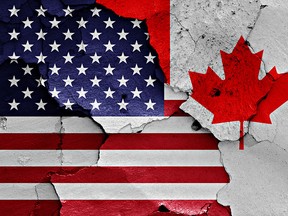March is too soon: The Bank of Canada should use its flexibility to support the recovery as long as possible
Article content
FP Economy essay series: Central banks need to use their flexibility to help the economy cope with inflexible supply chains
Advertisement
This advertisement has not loaded yet, but your article continues below.
Article content
The bond vigilantes are back. The Reserve Bank of Australia this week gave up trying to control bond prices because it would have had to create too much money to offset bets that inflation is a bigger threat than the RBA thinks it is. In Canada, yields on short-term debt started to rise around the beginning of autumn, even though Bank of Canada Governor Tiff Macklem continued to insist that his goal was to orchestrate a “complete” recovery from the COVID-19 recession. Last week, the Bank of Canada blinked, ending its bond-buying program and advancing the timetable for interest-rate increases.
Many investors and analysts have been suggesting that central banks should start removing policy accommodation sooner rather than later to fight the increase in inflationary pressures. However, given the nature of the shock, the decision for central banks will not be so easy. Their levers influence demand, and most of the upward pressure on prices is coming from issues with supply. Central banks can restrain inflation, but only by sacrificing economic output in order to create slack to compensate for the inflationary pressure due to a reduction in supply. This creates a dilemma: cooling inflation at the expense of employment, or tolerating higher inflation to allow further recovery in the labour market.
Advertisement
This advertisement has not loaded yet, but your article continues below.
Article content
Much of the volatility in financial markets stems from a misunderstanding about the nature of the COVID crisis. The recession was not a normal one. The downturn that followed the financial crisis in 2008 was triggered by a wave of bankruptcies that froze lending — a classic negative demand shock. Last year’s recession was more like a natural disaster. The distinction matters. When a flood affects a region, economic activity drops because everything stops. Once the water recedes, economic activity surges back to life, as production and consumption normalize, and the clean-up and rebuilding efforts take hold.
However, the recovery from a flood is inevitably bumpy. Shortages occur because demand never went away, while supply was disrupted, creating a mismatch. But within weeks, economic activity will have recovered and returned to normal. The COVID crisis is the same, only bigger (global vs. regional) and longer (years vs. weeks). The frictions that naturally come with a recovery from a natural disaster are therefore broad-based and stubbornly persistent. That magnifies the difficulties, but it doesn’t change the fundamentals: we’re still recovering from a natural disaster, not an energy crisis triggered by a regional oil cartel as in the 1970s, or an implosion of the global financial system like the one I witnessed as an economist in the City of London in 2008.
Advertisement
This advertisement has not loaded yet, but your article continues below.
Article content
The gross domestic product of most countries remains below pre-pandemic levels. This implies that a decline in global supply is mainly to blame for higher inflation. Consider the oil market. Global demand has recovered quite a lot, but it’s not back to where it was at the end of 2019. At the same time, supply is constrained: OPEC and America’s shale-oil companies have both cut production from pre-pandemic levels. The imbalance between demand and supply is the reason crude prices have surged by almost 75 per cent since the beginning of the year to their highest prices since 2014.
Similar things are happening across the global economy. So it is important to think about how an economy reacts to a demand shock versus a supply shock. The difference in the way each type of shock affects the economy will influence the way central banks react.
Advertisement
This advertisement has not loaded yet, but your article continues below.
Article content
An inflationary demand shock, often referred to as a positive demand shock, shifts the aggregate demand curve to the right. The result is an increase in economic activity (y) and an increase in price pressures (p). This is typically what would happen if interest rates were cut or the government was to increase spending or give money to households. The central bank would normally react to the increase in inflationary pressures by raising interest rates, which would lead to a decline in demand. As a result, economic activity is reduced, moderating inflationary pressures.
An inflationary supply shock, often referred to as a negative supply shock, shifts the aggregate supply curve to the left. The result is a decrease in economic activity (y) and an increase in price pressures (p). This is typically what would happen if a factory is closed or production inputs become unavailable, while consumers still desire to consume the goods and outbid each other. As in the case for a demand shock, the central bank would normally react to the increase in inflationary pressures by raising interest rates. The result on the economy will be the same: a decline in demand, a reduction in economic activity and a moderation in inflationary pressures. However, overall, the final equilibrium (y 3 and P 3 ) means a lower level of economic activity than in the case of a demand shock.
Advertisement
This advertisement has not loaded yet, but your article continues below.
Article content

The fact that a negative supply shock has a bigger negative impact on the level of economic activity also means that the new equilibrium will also involve a higher unemployment rate to reduce the inflationary pressures. This last part is important because it leads to a tradeoff for policy-makers between tolerating higher inflation and a lower unemployment rate or being more aggressive on inflation and having to tolerate a higher level of unemployment, all else equal. That’s why what Macklem was really saying when he said on Oct. 27 that, “it is our job to bring inflation back to target, and I can assure you we will do that,” was that he was prepared to risk stalling the recovery to keep inflation at target.
There is no denying that this year’s burst of inflation is causing problems for many countries, but if central banks overreact, it’s unlikely their efforts to cool prices will result in positive outcomes. Most of the countries that are being challenged by cost pressures are also heavily indebted. A lower growth rate, higher interest rates and higher unemployment would introduce new burdens. Canada, with its very high level of household and business debt, would likely underperform in this context.
Advertisement
This advertisement has not loaded yet, but your article continues below.
Article content
-

Bend it like Christine Sinclair — Carolyn Wilkins on what Canada’s policy makers could learn from women’s soccer
-

Why the fight against COVID-19 won’t end with a high vaccination rate
-

These two farming methods can feed the planet and help the environment — but they need to get along
Central banks’ mandates will ultimately dictate how they respond. Policy-makers with explicit direction from government to generate full employment, such as the leaders of the U.S. Federal Reserve, are likely to be more patient then central banks that have been directed to focus solely on price stability, such as Bank of England and the European Central Bank. Central banks with flexible inflation mandates like the Reserve Bank of Australia are also likely to be more willing to allow a rise in inflation and be less aggressive to fight inflationary pressures.
Advertisement
This advertisement has not loaded yet, but your article continues below.
Article content
In the case of the Bank of Canada, the central bank’s objective is to keep inflation between one per cent and three per cent, aiming at the midpoint of two per cent. While this could be viewed as a strict inflation target, history has shown that the Bank of Canada views its target with a certain amount of flexibility. This could allow the central bank some degree of patience in reacting to higher inflation to allow the economy to recover further before increasing its benchmark rate.
However, the most recent policy decision suggests that the Bank of Canada may not be willing to use this flexibility and has shown its intent to stop inflation from climbing any higher. But it could also be a tactic to keep a lid on inflation expectations. Judging by prices in debt markets, bond traders are attempting to push Macklem and his deputies in that direction. Prices suggest the first increase will come in early 2022.
That would be too soon. July remains a more reasonable target. The Bank of Canada should use its flexibility to support the recovery as long as possible and lower the amount of slack in the labour market. To be sure, if inflation expectations become unmoored, the central bank would have to respond. But this will be at the expense of a slower recovery and higher unemployment.
Charles St-Arnaud is chief economist at Alberta Central. He previously worked at the Bank of Canada and the Finance Department in Ottawa and for various international investment banks in New York and London.
Advertisement
This advertisement has not loaded yet, but your article continues below.
Pep talk for central bankers: don’t fear the return of the bond vigilantes
2021-11-05 17:22:04






